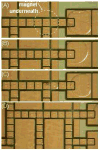Multiplexed real-time polymerase chain reaction on a digital microfluidic platform
- PMID: 20151681
- PMCID: PMC2859674
- DOI: 10.1021/ac902510u
Multiplexed real-time polymerase chain reaction on a digital microfluidic platform
Abstract
This paper details the development of a digital microfluidic platform for multiplexed real-time polymerase chain reactions (PCR). Liquid samples in discrete droplet format are programmably manipulated upon an electrode array by the use of electrowetting. Rapid PCR thermocycling is performed in a closed-loop flow-through format where for each cycle the reaction droplets are cyclically transported between different temperature zones within an oil-filled cartridge. The cartridge is fabricated using low-cost printed-circuit-board technology and is intended to be a single-use disposable device. The PCR system exhibited remarkable amplification efficiency of 94.7%. To test its potential application in infectious diseases, this novel PCR system reliably detected diagnostic DNA levels of methicillin-resistant Staphylococcus aureus (MRSA), Mycoplasma pneumoniae , and Candida albicans . Amplification of genomic DNA samples was consistently repeatable across multiple PCR loops both within and between cartridges. In addition, simultaneous real-time PCR amplification of both multiple different samples and multiple different targets on a single cartridge was demonstrated. A novel method of PCR speed optimization using variable cycle times has also been proposed and proven feasible. The versatile system includes magnetic bead handling capability, which was applied to the analysis of simulated clinical samples that were prepared from whole blood using a magnetic bead capture protocol. Other salient features of this versatile digital microfluidic PCR system are also discussed, including the configurability and scalability of microfluidic operations, instrument portability, and substrate-level integration with other pre- and post-PCR processes.
Figures






Similar articles
-
Development of a digital microfluidic platform for point of care testing.Lab Chip. 2008 Dec;8(12):2091-104. doi: 10.1039/b814922d. Epub 2008 Nov 5. Lab Chip. 2008. PMID: 19023472 Free PMC article.
-
Fast Thermocycling in Custom Microfluidic Cartridge for Rapid Single-Molecule Droplet PCR.Sensors (Basel). 2023 Dec 17;23(24):9884. doi: 10.3390/s23249884. Sensors (Basel). 2023. PMID: 38139729 Free PMC article.
-
Digital isothermal quantification of nucleic acids via simultaneous chemical initiation of recombinase polymerase amplification reactions on SlipChip.Anal Chem. 2011 May 1;83(9):3533-40. doi: 10.1021/ac200247e. Epub 2011 Apr 8. Anal Chem. 2011. PMID: 21476587 Free PMC article.
-
Single-molecule emulsion PCR in microfluidic droplets.Anal Bioanal Chem. 2012 Jun;403(8):2127-43. doi: 10.1007/s00216-012-5914-x. Epub 2012 Mar 27. Anal Bioanal Chem. 2012. PMID: 22451171 Review.
-
Rapid detection of methicillin-resistant Staphylococcus aureus directly from clinical samples: methods, effectiveness and cost considerations.Ger Med Sci. 2009 Jul 6;7:Doc06. doi: 10.3205/000065. Ger Med Sci. 2009. PMID: 19675746 Free PMC article. Review.
Cited by
-
Critical Study on the Tube-to-Chip Luer Slip Connectors.Front Med Technol. 2022 May 31;4:881930. doi: 10.3389/fmedt.2022.881930. eCollection 2022. Front Med Technol. 2022. PMID: 35711385 Free PMC article.
-
All-in-One Digital Microfluidics System for Molecular Diagnosis with Loop-Mediated Isothermal Amplification.Biosensors (Basel). 2022 May 11;12(5):324. doi: 10.3390/bios12050324. Biosensors (Basel). 2022. PMID: 35624625 Free PMC article.
-
Research progress of electrode shapes in EWOD-based digital microfluidics.RSC Adv. 2023 Jun 5;13(25):16815-16827. doi: 10.1039/d3ra01817b. eCollection 2023 Jun 5. RSC Adv. 2023. PMID: 37283873 Free PMC article. Review.
-
Novel microfluidic platform for automated lab-on-chip testing of hypercoagulability panel.Blood Coagul Fibrinolysis. 2012 Dec;23(8):760-8. doi: 10.1097/MBC.0b013e328358e982. Blood Coagul Fibrinolysis. 2012. PMID: 22964771 Free PMC article.
-
Development of New PCR Assay with SYBR Green I for Detection of Mycoplasma, Acholeplasma, and Ureaplasma sp. in Cell Cultures.Diagnostics (Basel). 2021 May 14;11(5):876. doi: 10.3390/diagnostics11050876. Diagnostics (Basel). 2021. PMID: 34068904 Free PMC article.
References
-
- Kricka LJ, Wilding P. Anal Bioanal Chem. 2003;377:820–825. - PubMed
-
- Roper MG, Easley CJ, Landers JP. Anal Chem. 2005;77:3887–3894. - PubMed
-
- Lagally ET, Emrich CA, Mathies RA. Lab Chip. 2001;1:102–107. - PubMed
-
- Ottesen EA, Hong JW, Quake SR, Leadbetter JR. Science. 2006;314:1464–1467. - PubMed
-
- Giordano B, Ferrance J, Huhmer AFR, Swedberg S, Landers JP. Anal Biochem. 2001;291:124–132. - PubMed
Publication types
MeSH terms
Substances
Grants and funding
LinkOut - more resources
Full Text Sources
Other Literature Sources
Medical

